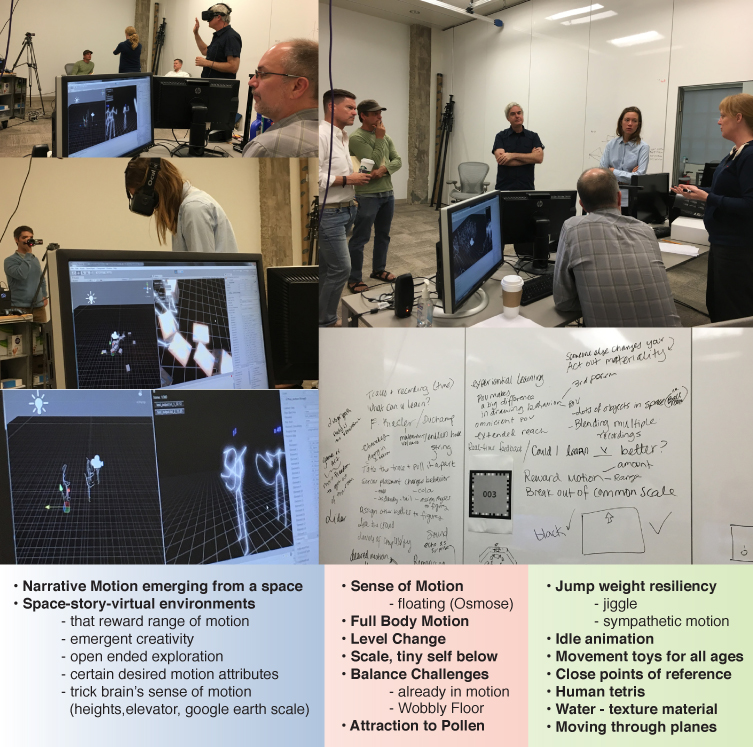As the Humane Technologies research team first began contemplating the 2016-2017 "Livable Futures" theme in Autumn semester, we held a series of sandbox sessions in the ACCAD labs and studios, each led by a different team member. The purpose of these sandboxes was to engage in a "doing thinking" process together with various humane technology frameworks in order to explore potential lines of inquiry, develop research questions, and build relationships. What follows are notes developed in conjunction with this particular sandbox session.
Sandbox: Kinect/Oculus Playdate with Alan Price
Wednesday, September 28, 9:30-11:30am in the ACCAD SIMLAB
Attendees: Stephen Turk, Candace Stout, Peter Chan, Scott Swearingen, Scott Denison, Alan Price, Norah Zuniga Shaw, Isla Hansen, John Welch
Anticipation / Expectation:
• To promote discussion and questions about full body engagement and motion in VR, capturing action with playback and real time drawing, and representation in VR spaces...
• To pose the question “what is this for?”
• To explore the VR format (presumably a current interest in use of HMDs with head tracking).
• To explore the embodiment in virtual space; multi-sensory compared with full-body engagement and representation (point-of-view/ gaze).
• To explore the recording of motion (playback, reflection, analysis, of how participants move and engage over time).
• To explore the internal development (starting the process of developing tools for portable templates and future sandboxes created in-house).
• To focus on the user reflecting upon his/her own body as the active element in the space, independent of any encumbrances such as hand-held wands or game controllers.
Disposition / Experience:
• How people are able to physically engage in a virtual space” in interesting, new, creative and/or healthful ways.
• What makes the VR Player do things that are fun to watch as well as fun for them?
• How desired motions could drive the game mechanics such as a desire for people to extend the range of motion, to change levels, to make cross lateral patterns and balance?
• Could additional bodies in space in the VR experience (either inside or outside) create a more interesting learning environment for a viewer / user / player?
• Could you create a dance score with moving objects in the virtual realm?
If so -- what are these objects?
• Who is our intended / ideal Audience? ... How do we want our experience to relate to and possibly change who they are or how they think?
• How can we enhance the experience to make evaluative design decisions within the virtual space?
• How to teach game design through new technologies that are not yet fully realized. (SS)
• How to better navigate the world than using handheld devices?
• Could it be that games are real, and toys are not? ... The context is fiction, but the decisions are real - and lasting.
Reflection / Opportunity:
• VR player as performer...
• We felt that interacting with our own recording-motion and the traced-forms made us more aware of their bodies (for better or worse).
• Obviously modeling of any kind is a richer experience in 3D, if I can build in layers and then dimensionally look through them.
• Recording motion was a hit. ... I want to go back in now and try to choreograph those figures.
• We were toying with the idea of human Tetris style game that did not require a lot of space to play and the environment could scale to your available real-world play space.
• It was very interesting for me when I began to think about physical motions as ‘player mechanics’ in a game-related environment.
• The third person perspective and omniscient high viewpoint were of interest.
• I really, really wanted my avatar to be an ‘it’.
• We are interested in play spaces that are physically, socially and creatively engaged.
• I’d like a humanist to help think about narrative and ethical contexts of some of this work and the relationship to post-humanism.
• This VR work that is in conversation with Ghostcatching, a kind of partial reconstruction would be fun.
• I’d like to make a 3d drawing experience that takes IMPROV TECHNOLOGIES into VR.
• I’d like to make something that invites cross lateral motion.
• The big thing I am thinking about is the place of movement qualities in a VR environment and how training a user to engage movement qualities could lead to more empathetic interactions with the world from a renewed understanding of one’s own movement proclivities which inevitably connect to emotions (how do humane technologies work toward that end). I am thinking specifically from the vocabulary associated with the Laban systems for movement qualities.
• I’m considering this balance as to how each medium [movement improvisations and VR generated environments] retains its integrity, but enhances the best traits about the other.... perhaps this ties into the discussion empathy and self/group awareness.
• I am thinking about the followings—the relationship between avatar and player; player driven goals; connections between environments; visual themes; activities; and the external world.
